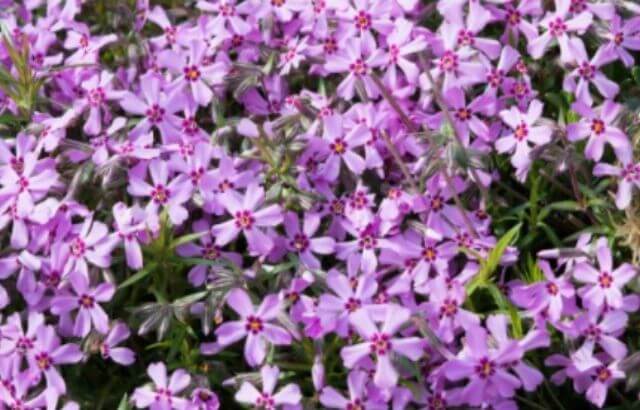How to Prune Phlox | Explained in Fewer Words (With Pictures)
Articles, products, and services offered on this site are for informational purposes only. We are part of the Amazon Services LLC Associates Program, an affiliate advertising program. Amazon.com is compensated for sales resulting from links on our website.
Please review our disclaimer before acting based on anything you read or see.
Garden phlox, or paniculata phlox, are tall and hardy plants suitable for the back of a flowerbed or in front of a building or fence. The large, fragrant flowers are displayed from July through September. Today we show you how to prune Phlox.
Phlox paniculata produces clusters of pure white flowers. The Perennial Plant Association named it a perennial plant of the year 2002. Phlox paniculata can be pruned to encourage flowering, control appearance, and seasonal cleaning. It may be appropriate to plant phlox bulbs in your garden.
How to Prune Phlox
Pruning and Caring for Phlox
Whether annual or perennial Phlox, care is fairly easy and generally boils down to watering when the ground is dry.
More regular watering is required for Phlox grown in pots, garden boxes, or containers.
Annual Phlox
- The most famous Phlox is the drummondii.
- It enjoys full sun and prefers fairly rich, well-drained soils.
- It needs regular watering, especially in times of drought.
Perennial Phlox
There are many varieties and species of Phlox, but they all have one thing in common: They love the sun.
- Always try to find sunny spots or places that are only shaded for a couple of hours.
- Make sure your soil is rich enough for beautiful blooms.
- At the beginning of spring, add fertilizer for flowering plants to the soil.
- Remove faded (wilted) flowers regularly.
Phlox in winter
Perennial Phlox will grow back each year, although it is better to cut back the foliage just after the first frost. It will quickly turn black if left on the plant. Protect with a creamy layer of dead leaf mulch.
You can pull annual Phlox because it does not regrow from year to year.
Where to Plant Phlox Garden

Perennial gardens
Garden phlox is a good companion to other summer-blooming perennials, such as lilies, bee balm, rudbeckia, Shasta daisies, yarrow, clematis, and lilies.
In flowerbeds, tall Phlox provide a good backdrop for lower plants.
This creeping Phlox Michigan can be very interesting, as can creep phlox care.
Cutting Gardens
The rigid and long trunks of the gardening phlox are very easy to place in a vase, where they complement and help support other flowers such as dahlias and lilies.
Cutting the stems while the flowers are still in the bud will extend their life in the vase.
How to Plant a Phlox Garden
- Loosen the soil to a depth of 13 “and mix in several handfuls of compost plus about ¼ cup of granular all-purpose fertilizer (follow package directions).
- Insert the plant into the hole so that the crown (The meeting point of the roots with the trunk) is at the ground line.
- Cover the roots well with soil and water.
Planting tips for Phlox
- Phlox needs a constant supply of moisture and will not tolerate drought.
- But before planting, compost or other organic matter should be added to improve the soil and retain moisture.
What to expect
- Phlox should have approximately 2 inches of water per week throughout the growing season.
- But keep the foliage’s appearance as healthy as possible, water in the root zone, and avoid wetting the leaves.
- Mulching surrounding plants with compost or shredded leaf debris helps to keep the soil moist and reduce weeds.
- Garden phlox can suffer from a fungal disease called powdery mildew.
- Although this disease is not very harmful to the plant, it can cover the foliage with an unattractive white powder.
- Powdery mildew is most problematic in warm, humid climates. To reduce the risk, good ventilation should be promoted.
- This can reduce infection rates by maintaining foliage as dry as possible.
Thinning
Garden phlox (Phlox paniculata), which grows 3 to 5 feet tall and is hardy in USDA zones 4 to 8, benefits from thinning early in the growing season.
- Cut back all but five or six of the strongest stems when the plant grows to a height of 6 inches, removing stems near the plant’s base with disinfected pruning shears.
- It is thinning causes the other stems to strengthen and have a large bloom. It also allows sufficient ventilation to minimize the effects of powdery mildew later in the season.
- After thinning the plant, take the tip of each stem between thumb and forefinger, and pinch just above the topmost growing shoot.
- She was pinching the trunks results in a bushier plant with more voluminous flowers.
Cut it back
- Deadheading phlox (removing old flowers) prevents seed formation, encouraging some phlox varieties to produce new shoots and new flowers.
- It also cleans plants for better appearance and mildew prevention.
- Cut back dead flower stalks of garden phlox at their bases immediately after the plant finishes blooming.
- Shorter Phlox have varieties, such as creeping Phlox (Phlox stolonifera). Hardy in USD zones 5 through 10, and moss phlox (Phlox subulata), hardy in USDA zones 2 through 8, should be cut back after they finish blooming.
- Cut back all plants by one-third to one-half their height.
Stop mildew
• The most prevalent disease of Phlox, powdery mildew, which leaves a powdery white coating on the plant’s leaves and flowers, is prevented by cutting and cleaning up after cutting. obstructing sunlight, ultimately resulting in the plant’s deterioration and death.
• To reduce the spread of this disease, cut badly diseased stems and leaves at any point throughout the growth season.
• Clean your hands after touching sick Phlox and sanitize your cuticle scissors after each cut to eliminate mold spores.
• As soon as possible, rake any fallen leaves and pruning trimmings to prevent them from harboring spores close to the phlox.
• Parasites and illnesses that affect phlox.
• Snails and slugs, which adore Phlox’s leaves, are the parasites that do the greatest damage.
• Powdery mildew infection may also affect phlox.
• A discussion and management of powdery mildew.
When and Where to Plant Phlox
The Phlox can be planted in the fall or spring and immediately upon receipt.
Light:
Both Phlox varieties enjoy full sun, although vertical garden phlox can take some afternoon shade, particularly in the south.
Soil:
- Phlox tolerates most garden soils, but well-drained soil is preferable, particularly in northern areas where spring snow is slow to drain.
- Wet, waterlogged spring soil can rot dormant roots.
- Add compost or peat to the garden to improve drainage and create a better overall environment.
Spacing:
- Garden phlox should be planted about 19 inches apart while creeping Phlox should be planted about 3 feet in height.
- Giving these plants plenty of room for air circulation is the key to limiting mildew growth.
- (Although most of the varieties available today have been bred to resist mildew).
- Over the next few years, you will see both varieties form clumps that will gradually increase and come together to form a large grouping of Phlox, with the Creeping variety creating a mat or carpet.
Fall planting:
In the fall, the plants are kept cool on the terrace for a few days until it is convenient for you to plant, but don’t let the roots dry out, and be sure to plant a few weeks before the first foot frost arrives.
Plant in spring:
Similarly, if the plant arrives in a spring container, keep the container moist until the soil is ready for planting.
Hold spring planting until the soil is free of melting snow and ice and is easy to work. The most convenient in many cases is to make an inch of soil.

How to Prune Phlox: FAQs
When should I prune Phlox?
Remember to remove dead/faded flowers so your plants can rebloom. If you have a tall phlox, cut the stems back to about 1 to 2 inches above the ground after the first killing frost in the fall. (Check local frost dates). Divide tall garden phlox every 2 to 3 years to ensure healthy, disease-free plants.
How do you maintain Phlox?
To maintain your phlox tree, it is necessary to keep the foliage as dry as possible by applying water to the soil instead of the foliage. Spread a 2- to 3-inch layer of mulch around the plants to help the soil retain moisture. Garden phlox care also includes trimming the flower stems after the flowers fade.
How do you Deadhead phlox?
- Cut back used flower clusters as soon as the flowers start to wilt with a small pair of scissors.
- Cut the entire flower spike once all buds have bloomed and no new buds form along the stem. Discard or compost the removed flower clusters and spikes after decomposition.
Conclusion
Phlox is a very visually pleasing plant that can be used to decorate your home and give it a lot of style and elegance. You must always keep your plant dubbed and care that it does not lack anything for safe growth.
Eventually, the best thing to do is plant a Phlox tree in your home. Although they require some care, they are certainly worth it. On many occasions, these trees can be of great help aesthetically speaking. As long as you keep them hygienic and don’t let them dry out, everything will be fine.



Comments are closed.